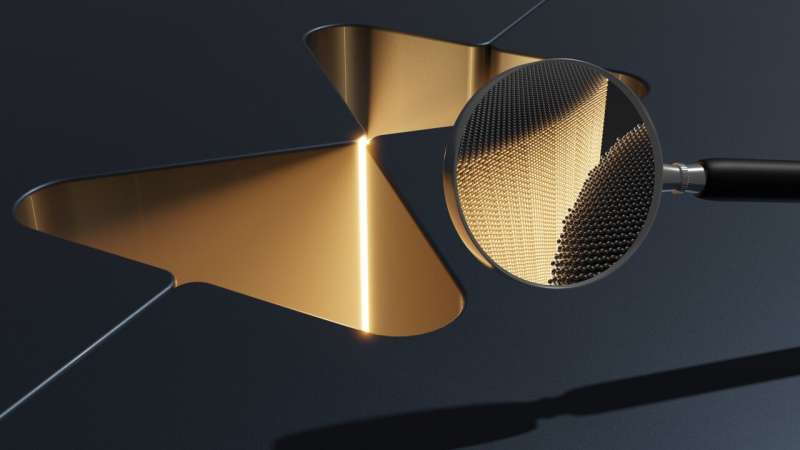This article has been reviewed according to Science X's editorial process and policies. Editors have highlighted the following attributes while ensuring the content's credibility:
fact-checked
peer-reviewed publication
trusted source
proofread
Bowtie resonators that build themselves bridge the gap between nanoscopic and macroscopic

A central goal in quantum optics and photonics is to increase the strength of the interaction between light and matter to produce, for example, better photodetectors or quantum light sources. The best way to do that is to use optical resonators that store light for a long time, making it interact more strongly with matter. If the resonator is also very small, such that light is squeezed into a tiny region of space, the interaction is enhanced even further. The ideal resonator would store light for a long time in a region at the size of a single atom.
Physicists and engineers have struggled for decades with how small optical resonators can be made without making them very "lossy," which is equivalent to asking how small you can make a semiconductor device. The semiconductor industry's roadmap for the next 15 years predicts that the smallest possible width of a semiconductor structure will be no less than 8 nm, which is several tens of atoms wide.
The team behind a new paper, Associate Professor Søren Stobbe and his colleagues at DTU Electro, demonstrated 8 nm cavities last year, but now they propose and demonstrate a novel approach to fabricate a self-assembling cavity with an air void at the scale of a few atoms. Their paper, "Self-assembled photonic cavities with atomic-scale confinement," detailing the results is published in Nature.
To briefly explain the experiment, two halves of silicon structures are suspended on springs, although in the first step, the silicon device is firmly attached to a layer of glass. The devices are made by conventional semiconductor technology, so the two halves are a few tens of nanometers apart.
Upon selective etching of the glass, the structure is released and now only suspended by the springs, and because the two halves are fabricated so close to each other, they attract due to surface forces. By carefully engineering the design of the silicon structures, the result is a self-assembled resonator with bowtie-shaped gaps at the atomic scale surrounded by silicon mirrors.
"We are far from a circuit that builds itself completely. But we have succeeded in converging two approaches that have been traveling along parallel tracks so far. And it allowed us to build a silicon resonator with unprecedented miniaturization," says Søren Stobbe.
Two separate approaches
One approach—the top-down approach—is behind the spectacular development we have seen with silicon-based semiconductor technologies. Here, crudely put, you go from a silicon block and work on making nanostructures from them. The other approach—the bottom-up approach—is where you try to have a nanotechnological system assemble itself. It aims to mimic biological systems, such as plants or animals, built through biological or chemical processes.
These two approaches are at the very core of what defines nanotechnology. But the problem is that these two approaches were so far disconnected: Semiconductors are scalable but cannot reach the atomic scale, and while self-assembled structures have long been operating at atomic scales, they offer no architecture for the interconnects to the external world.
"The interesting thing would be if we could produce an electronic circuit that built itself—just like what happens with humans as they grow but with inorganic semiconductor materials. That would be true hierarchical self-assembly," says Guillermo Arregui, who co-supervised the project.
"We use the new self-assembly concept for photonic resonators, which may be used in electronics, nanorobotics, sensors, quantum technologies, and much more. Then, we would really be able to harvest the full potential of nanotechnology. The research community is many breakthroughs away from realizing that vision, but I hope we have taken the first steps."

Approaches converging
Supposing a combination of the two approaches is possible, the team at DTU Electro set out to create nanostructures that surpass the limits of conventional lithography and etching despite using nothing more than conventional lithography and etching. Their idea was to use two surface forces, namely the Casimir force for attracting the two halves and the van der Waals force for making them stick together. These two forces are rooted in the same underlying effect: quantum fluctuations.
The researchers made photonic cavities that confine photons to air gaps so small that determining their exact size was impossible, even with a transmission electron microscope. But the smallest they built are of a size of 1–3 silicon atoms.
"Even if the self-assembly takes care of reaching these extreme dimensions, the requirements for the nanofabrication are no less extreme. For example, structural imperfections are typically on the scale of several nanometers. Still, if there are defects at this scale, the two halves will only meet and touch at the three largest defects. We are really pushing the limits here, even though we make our devices in one of the very best university cleanrooms in the world," says Ali Nawaz Babar, a Ph.D. student at the NanoPhoton Center of Excellence at DTU Electro and first author of the new paper.
"The advantage of self-assembly is that you can make tiny things. You can build unique materials with amazing properties. But today, you can't use it for anything you plug into a power outlet. You can't connect it to the rest of the world. So, you need all the usual semiconductor technology for making the wires or waveguides to connect whatever you have self-assembled to the external world."
Robust and accurate self-assembly
The paper shows a possible way to link the two nanotechnology approaches by employing a new generation of fabrication technology that combines the atomic dimensions enabled by self-assembly with the scalability of semiconductors fabricated with conventional methods.
"We don't have to go in and find these cavities afterwards and insert them into another chip architecture. That would also be impossible because of the tiny size. In other words, we are building something on the scale of an atom already inserted in a macroscopic circuit. We are very excited about this new line of research, and plenty of work is ahead," says Søren Stobbe.
More information: Søren Stobbe, Self-assembled photonic cavities with atomic-scale confinement, Nature (2023). DOI: 10.1038/s41586-023-06736-8. www.nature.com/articles/s41586-023-06736-8
Journal information: Nature
Provided by Technical University of Denmark



















